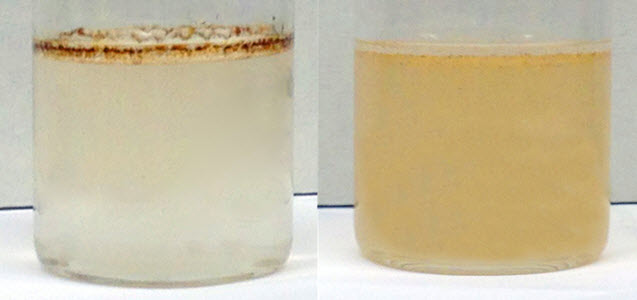
This figure depicts two vials in which a thin layer of crude oil was placed over simulated sea water. Different dispersants were added to each vial, and the vials were lightly shaken and photographed 30 minutes later. The left vial shows an example of bad or ineffective emulsion, where the crude oil remains as a dark brown slick on the water’s surface and the water column contains negligible oil. The right vial shows an example of good and effective emulsion, where the crude oil is dispersed into small droplets in the water column. (Photos by Jasmin Athas)
Oil spill responders currently have the option to treat oil spills with a synthetic dispersant called Corexit, however scientists continue to search for alternatives. In this search, scientists seek to develop an understanding of the specific mechanisms that drive dispersion and identify an effective combination of food-grade components.
The Gulf of Mexico Research Initiative (GoMRI) awarded Dr. Srinivasa Raghavan a grant to investigate and identify a viable alternative to Corexit. Dispersants contain surfactant compounds that help break up oil into tiny droplets, particularly when the oil encounters agitations such as wave motion. Preliminary research identified soy lecithin, a nontoxic food-grade surfactant, as a viable replacement for dioctyl sodium sulfosuccinate (DOSS), a synthetic surfactant that is one of Corexit’s major oil-dispersing compounds.
The team will study the fundamental mechanisms of efficient dispersion to reveal ways that dispersant formulations can be enhanced and optimized for a variety of complex applications, such as dispersing highly viscous or weathered oils. The researchers will apply various combinations of lecithin and other widely available food-grade surfactants to a thin oil layer on a simulated saltwater sea surface and identify which formulations best disperse oil. They will examine how much oil is dispersed and the dispersed oil’s stability to remain in the water column and not recoalesce at the surface.
Once the team identifies the most effective formulations, they will investigate the factors that contribute to effective dispersion. This process will include assessing the mechanisms behind oil dispersion and the way those mechanisms differ from emulsification (the stable suspension of oil droplets in water when mixed vigorously). The researchers hypothesize that a dispersant’s effectiveness is heavily influenced by its molecular nanostructure. “That is the true mystery aspect of this research – why are some formulations better than others?” said Raghavan. “We are finding that in the current literature there is no good answer to this question.”
The team hopes their findings will influence future dispersant design towards more effective and environmentally benign formulations. Raghavan commented, “We’ve set out to find an effective, nontoxic formulation that we can clearly prove is better than the current standard. Our hope is that our data and findings will be eye-opening and generate an incentive for change.”
The project’s researchers are Srinivasa Raghavan at the University of Maryland Department of Chemical and Biomolecular Engineering, Geoffrey Bothun at the University of Rhode Island Department of Chemical Engineering,Vijay John at the Tulane University Department of Chemical and Biomolecular Engineering, and Alon McCormick at the University of Minnesota Department of Chemical Engineering and Materials Science. Their project is Molecular Engineering of Food-Grade Dispersants as Highly Efficient and Safe Materials for the Treatment of Oil Spills.
************
The Gulf of Mexico Research Initiative (GoMRI) is a 10-year independent research program established to study the effect, and the potential associated impact, of hydrocarbon releases on the environment and public health, as well as to develop improved spill mitigation, oil detection, characterization and remediation technologies. An independent and academic 20-member Research Board makes the funding and research direction decisions to ensure the intellectual quality, effectiveness and academic independence of the GoMRI research. All research data, findings and publications will be made publicly available. The program was established through a $500 million financial commitment from BP. For more information, visit http://gulfresearchinitiative.org/.
